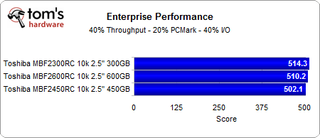Analysis: Which Enterprise Capacity Point Performs Best?
SSDs are best for performance. SATA hard drives provide maximum capacity. Enterprise-class SAS disks are the workhorses positioned between them. But which enterprise hard drive capacity makes sense when there are several from which to choose?
Conclusion

The differences between these three technically-identical drives are small, but the discrepancies might be important for IT decision makers that need to purchase dozens or even thousands of drives. The largest hard drive does not necessarily deliver the best performance or power efficiency, and the top-performing drive isn't necessarily tops in capacity per watt.
We used the three Toshiba MBF drives to illuminate the differences between products within one product family. We would expect the overall results to be similar if we'd used Seagate’s Savvio 10K.4 drives. More platters translate into higher power consumption and higher drive surface temperature. Both result in more intensive cooling requirements for rackmount servers, which can hold hundreds of these drives. However, going for highest-capacity scenarios requires the largest capacity per drive, and from this standpoint you’ll get maximum capacity per watt when selecting the highest-capacity drives, knowing that the power consumption differences are nowhere near the capacity differences.
The 600GB top model turned out to be the most balanced choice, delivering good or best I/O performance, best application performance, and good throughput results—but at the highest cost. The 450GB model is stuck in the middle, although it may be a good option if you can’t ignore capacity completely and if the price is right compared to the other versions.
The 300GB model delivered the best throughput, lowest power consumption, and, as a direct result, the best performance per watt efficiency for both I/O and throughput operations. Efficient data processing arrays are best off with this entry-level capacity point as long as capacity requirements permit. The 600GB version appears to be the most balanced choice for server applications, especially since you may be able to reduce the amount of drives in each array thanks to the drives' high capacity.
Stay on the Cutting Edge
Join the experts who read Tom's Hardware for the inside track on enthusiast PC tech news — and have for over 25 years. We'll send breaking news and in-depth reviews of CPUs, GPUs, AI, maker hardware and more straight to your inbox.
Most Popular

